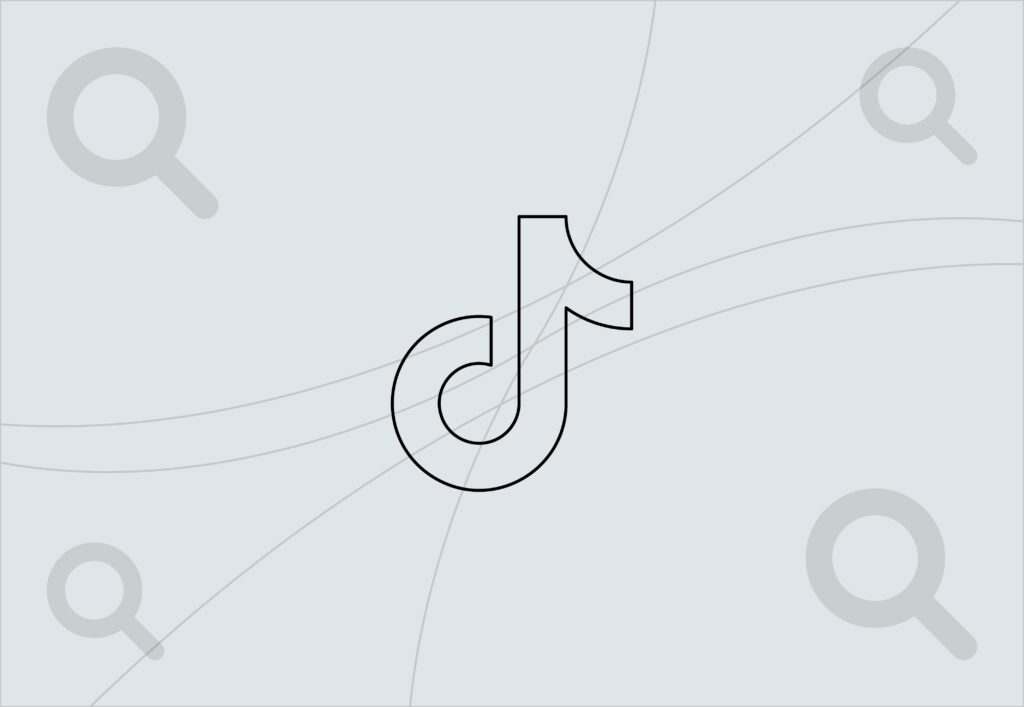
On-site SEO vs Off-site SEO: Why you need both

We often talk about the three pillars of SEO – content, authority and technical – that underpin everything we do. So where do on-site SEO and off-site SEO fall into the picture?
Well, it overlaps both.
Think of it like this, if you’re growing a plant in your garden, the three pillars of SEO are the essentials – the seeds, the soil, and the water. On-site and off-site SEO are how you use them. on-site SEO is like planting the seed in the soil and tending to its growth, while off-site SEO is everything outside of the garden, such as the rain. While you can influence, such as watering the plant, you don’t always have full control.
When you’re looking at the SEO for your website it is important to consider the essentials, how you grow and the external elements. This might seem like a long to-do list, but you don’t need to do it all at once. A good SEO strategy covers all areas, but in a priority order depending on time and budget (and that’s usually where my skills come in.)
So what is on-site SEO?
On-site SEO, also known as on-page SEO, are the elements of a website that crawlers crawl to index and rank your website. Each element is “on page” on the website and you can manipulate it to best represent what search engines and your customers are looking for.
On-site optimisation refers to changes you can make to these elements to rank higher on the search engine results page (SERP). Good on-site optimisation tells a crawler what the page is about and what a human would see which is why quality on-page optimisation is vital for your website.
So let’s dive into our first element of on-site optimisation.
Content
High-quality, relevant content is arguably the most important element of not only your on-site SEO but also your website. So how do you write high-quality content?
The content you write for your website must bring something to the table, do not just regurgitate what your competitors have written. It is important to capture your customer’s attention, reflect their needs, explain your USP and ultimately drive your customers to take action.
But what makes great content?
There’s not one simple answer – there are various elements that make up a great piece of content. Our Senior Content Manager, Shona Worsman, says:
“Great content needs to captivate, inspire and encourage readers to take action. You need to consider the emotion impact of your words, create unique and tailored content for your audience and of course, you can’t forget about search engine optimisation”.
Interested in hearing more? Keep reading about what makes great content here.
Of course, while I mention content, I must give a nod to E-E-A-T (experience, expertise, authoritativeness and trust) everyone’s favourite acronym when it comes to high-quality content. E-E-A-T is the guidelines that Google uses to determine the ‘most helpful’ (and therefore the best) content on the web. E-E-A-T considers a range of factors that help crawlers determine ‘helpful’ content which should be ranked higher.
How to action?
- Create a content marketing strategy tailored to your customer
- Write high-quality and E-E-A-T optimised content that brings something new to the table
Embryo is a Manchester-based SEO content marketing agency, we produce SEO content that resonates and ranks high. If you’re interested, please do get in touch.
Metadata
Metadata is a piece of text that you place within your HTML to explain to search engines the purpose of that page. All metadata should be unique so search engines are clear as to why each individual page on your website should exist and also rank.
There are 5 essential meta tags you should know:
- Title Tags
- Heading Tags
- Meta Descriptions
- Alt Tags
- Schema Markups
These pieces of metadata are key elements of your web content and are usually one of the more important ways to optimise your website. If you want to know more about essential meta tags, we have recently done a blog on the five essential meta tags you need to know about.
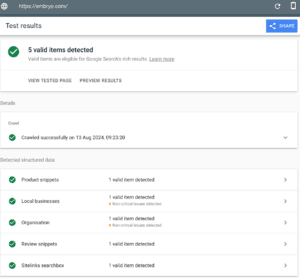
How to action?
- Give all pages on your website unique page titles, headings and meta descriptions
- Add descriptive and informative alt tags to your images
- Add schema markups as and when relevant
- Keep the length of the title tag to fit on the SERP – I like to use this meta title & description preview tool
Onsite keyword optimisation
Hand in hand with both content and metadata are keywords. One of the key onsite SEO tools, keywords within your content and metadata are what tell search engines the intent of the page.
A good keyword strategy with give each page a unique batch of keywords that describe what is on that page and no other. The aim is to use keywords that have a high search volume and the right intent and are used naturally throughout.
Can you guess what the keyword of this blog is?
How to action?
- Add the keyword to the start of your page title
- Add the keyword towards the start of your content, and then naturally throughout
- Do not keyword stuff the content, or hide it in white text on the page
- Use the keywords in anchor text when linking to the page
URL Structure
One area of on-page SEO that can sometimes be forgotten is the URL structure. Similar to the page title, using the keyword in the URL can be another indicator to search engines of the intent of this page.
/blog/onsite-seo-vs-offsite-seo is much clearer than /blog/7485767
How to action?
- Most CMS’ will auto-generate your URL structure based on your H1, therefore if your H1 is optimised so will your URL structure
- Keep it simple, have a clear folder structure and use the keyword in your slug
- Uses hyphens (-) instead of spaces for readability
Internal Linking
We’ve spoken a fair bit about the content and text across your website, yet I’ve said that onsite SEO and offsite SEO span across the three pillars. This is where the authority pillar enters.
Often when SEOs talk about authority we talk about outreach opportunities and Digital PR. However, internal linking can help boost the authority of pages across your website without ever leaving your domain.
As with external links, every link to a page is a vote of confidence in the eyes of a search engine. Therefore the more links across your site – with clear anchor text – the better search engines understand your site structure and the importance of individual pages.
How to action?
- There are many ways in which you can create an effective internal linking strategy. If you want to know more, we’ve already produced a guide to internal linking for SEO here.
Images
Similar to URL structure, image optimisation can be another one of the forgotten elements of on-site SEO, and it really shouldn’t be.
Our Head of Creative Cameron Barrington says “Images bring websites to life. Adding an image makes your content stand out and if well optimised can have the added benefit of improving your search engine rankings”
Image optimisation can span across a range of different techniques, and you’ve guessed it we’ve done a blog on image optimisation that you can read here.
The two key elements of image optimisation are optimising for speed and optimising for readability.
How to action?
- Image optimisation for speed includes ensuring the image is scaled to reduce your site loading time. Reduce your file size through resizing and compression.
- Image optimisation for readability includes adding descriptive captions and SEO-friendly alt tags.
- Your CMS may have an image optimisation plugin that can help with both elements
Page Speed
It is all well and good search engines crawling your website, but what if the user struggles to access it? This is where the third pillar of SEO enters the game and we look at page speed.
Page speeds look at how fast your website is loading and can affect both your customer usability and your rankings. Multiple factors affect your page speed from how quickly customers can interact, to how much the page moves around when loading.
How to action?
There are many elements of page speed that you need to consider. The first step should be Google’s Page Speed Insight Tool which shows how well you perform in the eyes of Google.
Here is how Embryo is performing:
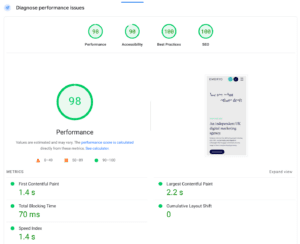
What are the most common issues when it comes to on-site optimisation?
No SEO journey is the same, and unfortunately, there is no standard checklist that will get your ranking in position 1 for your primary phrases. However, here are a few common issues I see when starting with new clients:
- Keyword cannibalisation – the same keyword is used across multiple pages of the website so search engines are unclear about what page to rank
- Poor meta titles – meta title tags that have not been optimised for the primary keyword so search engines are unclear of the page’s intent
- Unclear site structure – imagine reading this blog without clear headings, it would be much harder to read. Adding clear structure to this blog, and a website makes it much easier to read for both humans and crawlers
On-page is optimised, now what?
I’m going to go on a little detour but bear with me.
If you’ve followed Embryo for a while or you’ve been lucky enough to hear a talk from our Chief Innovation Officer James Welch you’ll know what I mean when I say ‘network science’ and that SEO hasn’t changed in two decades.
If you’re new here, welcome, let me explain.
Network science is the practice of studying networks and the relationships between them. These networks may grow, shrink, split, combine, and change over time but they are integrated into all areas of society….even SEO.
The key aim of optimising your website is for it to grow and bloom and bring you customers. How do you do this? By producing on-site optimised content and expanding off-site links and awareness.
Now you see where I am going…
Offsite optimisation is about using network science to bring traffic to your website. By using these four techniques you can grow your website and ultimately your network.
So let’s get started with offsite SEO
When we talk about off-site SEO, also known as off-page SEO, we’re talking about everything you can do to optimise your website that doesn’t start from your domain.
Many of these off-page optimisation techniques cover the ‘authority’ pillar of SEO and help to build out the network your website has on the World Wide Web.
So let’s get started.
External Links
One of the biggest ways you can boost the authority of your website is by increasing the number of external links pointing to your domain.
There are multiple ways to do this, from guest blogging, to link reclamation to running a Digital PR campaign. The most important factor with any link is that it is relevant to your website.
All websites have a third-party “domain ranking” metric, often on a scale of 1-100. Really simply, the higher the number of external websites pointing to your website, the more impressive the link.
Here is Embryo:
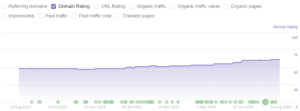
However, it’s not quite that simple, not all links are the same. Search engines take into account the quality and relatability of that link. If you’re a dog food company with a link from a high “DA” (domain authority) website that sells building supplies, that won’t give you as much of a boost as a link from Crufts.
Of course, running a Digital PR campaign can be indispensable in building brand awareness and growing your network.
How to action?
- There are so many link-building techniques to help with your SEO strategy that it would take a whole other blog to explain, so that’s what we’ve done.
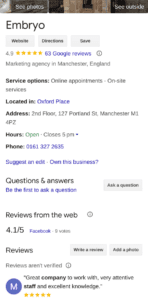
Local Listing
If you’re a business with a physical presence, local listings are a great way to optimise your offsite SEO.
A local listing is when you’re company is mentioned on another website with details such as your company name, address, content details, website etc.
This can be done in a range of ways from quality directories, blogs, social media, or search engine business profiles (such as Google Business Profile).
How to action?
1. Create a Google Business Profile, adding as much information as you can about your business
2. Add your details to local and high-quality directories
3. Add your details to any social media profiles you own
Reviews
It can sometimes be daunting to put yourself on a review website. However, remember a good review can be rather persuasive when it comes to customers making a purchase or choosing you over a competitor.
Not only are reviews an E-E-A-T factor, but they can help convert a customer, the good, the bad and the ugly.
How to action?
- Create a profile with a review company: for example, Trustpilot, Feefo, Google Business Profile
- Reply to all reviews, both positive and negative
- Action any negative reviews
- Add customer review comments and widgets to your website for an additional on-page boost
Social Media
And finally one of the almost forgotten ways you can boost your off-page SEO is through having a social media presence.
People don’t just use search engines to search – 53.2% of people under 24 wouldn’t even use search engines for their searching.
Social signals can boost your search visibility as they have an indirect influence on your online presence. While they may not increase a particular content or article organically, the likes, clicks and reposts all increase your brand awareness.
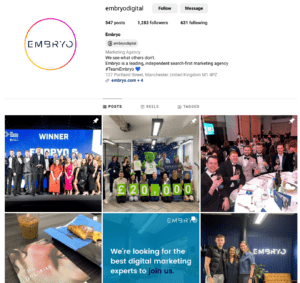
If search engines see a high session duration on your social media platforms, it is a strong indicator that your content is relevant and has value.
How to action?
- Create and regularly post on relevant social media platforms to your customers
- Ensure your profile is up to date with the latest contact details for your company
- Add links to your website where possible
What are the most common issues when it comes to off-site optimisation?
The primary issues when looking at off-site optimisation are the time it takes and the ability to measure.
Increasing your online visibility and domain authority takes a considerable amount of time. If your competitors are also optimising, it can take even longer. In addition to this, it’s likely you’ll need an ‘always on approach’ as the moment you stop, your competitors start to pull away again.
It is also impossible to measure the full impact. While you may see a bump in traffic during a digital PR campaign or after a successful link, the longer-term positive effects of your optimisation are often hard to quantify, especially if you’re doing other SEO at the same time.
You need both on-site SEO and off-site SEO
As we can see, there are many techniques available to you to improve your SEO across on-site and off-site SEO.
(And we’ve not even touched technical SEO really…)
If you believe that your website could benefit from one or more of the above suggestions, please get in touch. To learn more about how we do all areas of SEO, get in touch today! Hit the contact button below, call us on 0161 327 2635 or email info@embryo.com.
